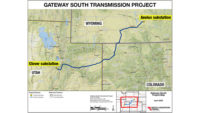NJ Pushed to Curb Gas Projects In Clean-Energy Future

NJ plan boosts offshore wind energy goal (l), but state also may permit LNG export terminal construction on Delaware River industrial site.
GRAPHIC (LEFT) COURTESY OF NJ ECONOMIC DEVELOPMENT AGENCY; PHOTO (RIGHT) COURTESY OF OFFICE OF NJ ATTORNEY GENERAL
New Jersey appears to be somewhat conflicted as it transitions to renewable power resources from fossil fuels to combat climate change.
The state released on June 10 a comprehensive draft energy master plan to guide the law signed by Gov. Phil Murphy (D) last year to meet by 2050 a goal of 100% renewable energy and 80% emissions cuts from 2006 levels.
But two days later, the state’s delegate to the Delaware Basin River Commission voted to approve a permit for a New Jersey terminal whose developer now indicates it will include liquefied natural gas exports.
New Jersey’s power generation sector accounts for about 20% of its net greenhouse gas emissions, mostly linked to heavy natural gas use for heating and electricity that could be costly to alter. But to achieve master-plan goals and transition to a clean-energy economy, the state must “model, assess and implement ways to minimize reliance on natural gas,” says the document.
“The approval doesn’t make sense coming from a governor who is so concerned about climate change,” Jeff Tittel, executive director of the New Jersey Sierra Club, told ENR.
Environmental groups say the plan to add the LNG terminal to the new port in Gibbstown, N.J., sought by Delaware River Partners, was kept secret.
The commission said earlier this month it had only been notified recently of the developer’s plan to add capacity to export 3.5 million gallons per day of LNG. The facility, set to cost an estimated $450 million to build, remains subject to final approvals by the state’s environmental agency and the Army Corps of Engineers.
New Jersey action on a $1-billion, 24-mile extension of the Transco natural gas pipeline also appears to perplex project opponents.
State officials on June 5 rejected two key environmental permits for the project, sought by Oklahoma-based project developer Williams Cos. But because those denials were done “without prejudice,” says Tittel, Williams could resubmit and did so on June 13.
“It’s another example of the governor trying to have it both ways,” he says. Advocates are pushing the Murphy administration to impose a moratorium on all new fossil-fuel projects.
The state has taken a stronger stance against the planned $1.2-billion PennEast pipeline, set to carry natural gas 120 miles from northern Pennsylvania to central New Jersey.
On June 10, it argued before a federal appeals court against approval by the Federal Energy Regulatory Authority for project developers to seize needed properties by eminent domain.
The state also halted review of a new $1.5-billion natural gas-fired power plant in the New Jersey Meadowlands near New York City after its developer moved to revise its air-quality application, said online business publication New Jersey Spotlight on June 18.
About one quarter of land for the project is protected, says a report prepared by Cadmus Group for the New Jersey Conservation Foundation. It says pipeline operation would produce about 269,000 tons of carbon dioxide emissions annually.
While the draft clean-energy master plan does not mention issues linked to natural gas pipelines, including greenhouse gas emissions, the document for the first time analyzes how the state’s transportation sector can shift from fossil fuel reliance by electrifying transit and promoting electric vehicles, among other strategies.
But according to Sierra Club’s Tittel, the plan changes the definition of clean energy to carbon neutral, which he contends could allow the use of generation methods that are not necessarily clean, such as carbon sequestration, carbon credits and offsets and nuclear power.
The New Jersey Board of Public Utilities is set to select this month a winning bidder for its 1,100-MW offshore wind solicitation, the first phase of a 3,500-MW construction commitment. Proposals have been submitted by Danish developer Ørsted North America; a team of French unit EDF Renewables and Shell; and Equinor, a Norwegian firm.
BPU should assess opportunities to build added offshore wind capacity beyond that goal and determine how much of state power demand should be met by offshore generation, the master plan says. The U.S. Energy Dept. says U.S. lease areas off New Jersey could support up to 12.5 GW of offshore wind and possibly more.
According to the new strategy, Murphy’s clean-energy program comes as the global energy system faces “substantial disruptors to traditional business models.”
It says the challenge of reaching 100% clean energy will take new technology, changes to the regulatory structure and a market redesign.
Feedback from the draft will provide to regulators more direction in developing targets and milestones to be contained in the final master plan.





